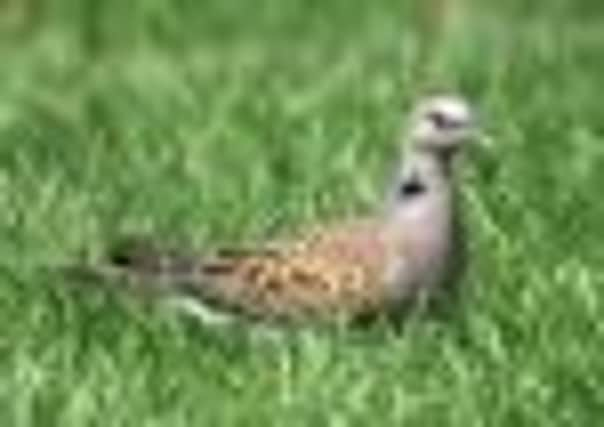Birdwatch: Malta slaughter has turtle doves reeling


The soft purring call of the male, a double purr like a contented cat, is one of nature’s most soothing sounds.
Turtle doves are also associated with marital harmony, perhaps because a pair newly arrived back from Africa will sit side by side touching beaks.
Advertisement
Hide AdAdvertisement
Hide AdTheir name has nothing to do with turtles but is derived from the scientific name, turtur, which is in turn derived from the turtle dove’s crooning song.
Turtle doves are easily distinguished from their much more widespread relative, the collared dove, by their rich chestnut-coloured backs – collared doves are much greyer birds.
And turtle doves have a distinct panel of black marks on their necks while collared doves have just a line or two.
Turtle doves have become increasingly scarce in many parts of Yorkshire but one place they have returned to this year after a five-year absence is the RSPB’s Fairburn Ings reserve where two pairs are thought to have bred near the new riverside trail.
Advertisement
Hide AdAdvertisement
Hide AdThey are still to be found at several places in East Yorkshire, while probably the most reliable place in the county to see and hear them is in Wykeham Forest, North Yorkshire, where four have been showing around the tree nursery. Another two have been seen near the visitor centre at Sutton Bank.
Their disappearance from many other places in the county is linked to a national decline of some 75 per cent over the past 70 years.
In this country, modern agriculture has played its part in this decline.
Turtle doves have a great liking for a farmland plant called fumitory which at this time of year can make up 60 per cent of its food intake, while chickweed is another important food source.
Advertisement
Hide AdAdvertisement
Hide AdBut on farmland, these ‘weeds’ are often sprayed with herbicide so they are no longer available for turtle doves, which, unlike other doves, do not take large amounts of grain in their diet.
But the main reasons for the turtle dove’s decline, both in Britain and elsewhere in Europe are to be found in Africa and around the Mediterranean.
In Africa, where turtle doves spend the winter south of the Sahara, they are subjected to the effects of periodic drought and creeping desertification, which deprives them of food.
But it is on their migration north in spring that they face their greatest hazards, when many thousands continue to be shot and trapped by hunters around the Mediterranean.
Advertisement
Hide AdAdvertisement
Hide AdIn Malta alone, the annual slaughter of turtle doves, and many other birds, continues despite it being illegal under the terms of the EU Birds’ Directive.
Waders seen in the region include an adult white-rumped sandpiper, at the RSPB’s Saltholme reserve, on Teesside, and a marsh and a curlew sandpiper at Blacktoft Sands.
Storm petrels were seen at several places along the Yorkshire coast with one caught and ringed at South Landing, Flamborough. One or two Balearic, sooty and Manx shearwaters have also been seen.
Michael Flowers is taking bookings for his East Yorkshire birdwatching classes, due to start in early September. As the course is timed to coincide with the autumn migration, several of the sessions will be held at coastal locations.
If you are interested in booking a place, contact him at [email protected] or on 07946 625688.